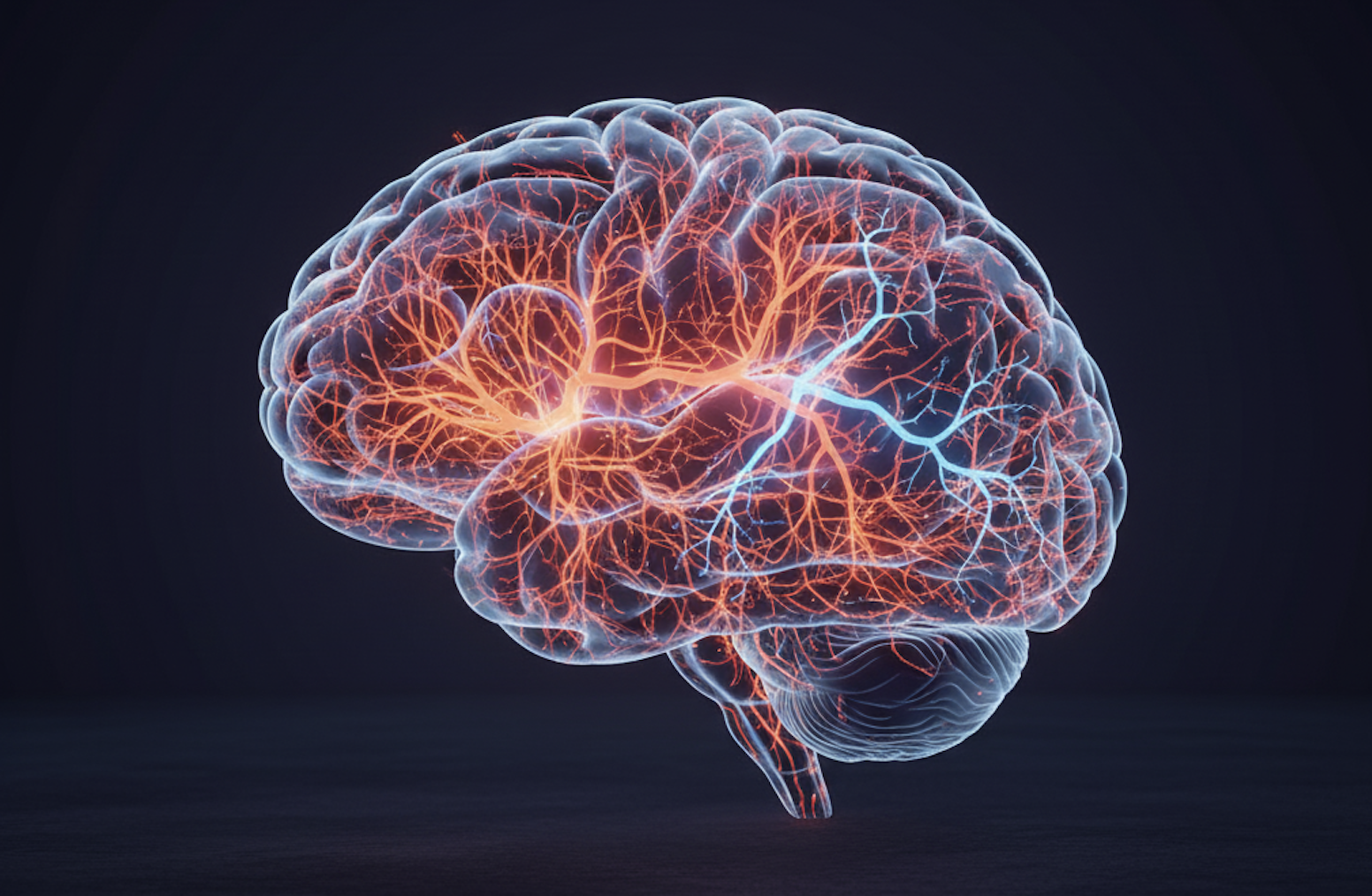The recorder chirps to life — “Yeah, it’s working” — and four people lean toward a small conference table at Lumin Health. Outside, the clinic hums with the usual choreography of blood pressures, consent forms, and the gentle logistics of people trying to feel better. Inside, the agenda is unexpectedly scientific for a corporate meeting: glutamate, GABA, synaptogenesis, brain‑derived neurotrophic factor. The question beneath all of it is practical: how do you explain to a person who is not sleeping, not hopeful, and not sure what to try next that a molecule first famous in operating rooms might help their brain learn to change?
Dr. Ben Yudkoff, a psychiatrist with a teacher’s patience, takes the first swing. “If the brain is a city,” he says, “glutamate is the green light. It’s the “go” signal — an excitatory neurotransmitter that pushes messages from one neuron to the next. But no city runs on green lights alone. You need GABA, the red light that tells traffic when to pause so something coherent can emerge from the grid. Too much green, and the boulevards jam; too much red, and nothing moves. Our moods, motivations, and habits are downstream of countless intersections where this balance is managed in real time.”
The way the brain enforces that balance has a beautiful economy to it. Cells that release GABA keep an ear out for the volume of glutamate, and if the excitatory chatter grows unruly they push back — “feedback inhibition,” in medical language; common sense, in spirit. The receptor that lets those GABA “hall monitors” listen is called NMDA. Ketamine’s psychiatric trick is not to floor the gas or cut the brake lines, but to muffle the hall monitors. It sits on NMDA receptors like fingers in the ears. The GABA cells don’t “hear” glutamate as efficiently, so they issue fewer stop‑signals. For a short while, the city tilts toward green.
That temporary glutamate surge is the part most people never hear about. It isn’t euphoria, it’s a workout. On the receiving side of the synapse, a spike of activity flows through AMPA receptors and stresses the cell in the same way a barbell stresses a biceps — mildly, constructively, as long as the dose is right and the rest is real. Stressed in this way, neurons release brain‑derived neurotrophic factor (BDNF), a growth cue that promotes “synaptogenesis” — the making and stabilizing of new connections between brain cells.
Here the conversation shifts from chemistry to opportunity. Depression, viewed at brain cell network scale, is not only a mood but also a communications problem: too few or too fragile pathways linking areas that should modulate one another. A hippocampus holding usable memories can’t quite reach a precuneus weighing the emotional tone of daily events. A nucleus accumbens built to register reward doesn’t reliably sway the circuits that decide whether an effort is worth it. Signals get through, but like a cell phone with one bar — clipped, delayed, prone to dropout.
New synapses don’t guarantee new thoughts, Dr. Yudkoff says, any more than buying weights makes you strong. What ketamine seems to offer is a window when the brain is unusually ready to learn — many clinicians talk about the first several days after treatment as a period of heightened plasticity — and what gets built in that window depends on what you practice. Therapy helps. So do self‑guided routines that feel almost quaint when written out — morning sunlight, consistent sleep, honest journaling, a ten‑minute walk even when you don’t want to. Ketamine doesn’t replace those efforts. It increases their yield.
Business jargon falls away as the group talks. There’s no “journey” language, none of the empty uplift that patients learn to filter out. Instead there is the strangely intimate work of getting metaphors right. Traffic lights for glutamate and GABA. Fingers in ears for NMDA blockade. A gym floor for synaptogenesis. The analogies are not decoration - they are handles. People can’t act on physiology they don’t understand.
Someone asks whether esketamine — the FDA‑approved nasal spray — works differently than ketamine, the older racemic mixture. Not at the level that matters for this story, Dr. Yudkoff says. Both tilt the system the same way with respect to glutamate. The meaningful differences are pragmatic. Esketamine (which is the left-oriented molecule of ketamine) is delivered intranasally in a clinic under a formal program. It’s more predictably absorbed through mucous membranes (the pink skin that lines our noses, mouths, etc.) and is covered by insurance. Racemic ketamine includes both S‑ and R‑forms (the right-oriented molecule of ketamine). In psychiatric care it is typically given by IV or injection, routes that avoid some of the variability of oral or take‑home intranasal use. One is on‑label, the other off‑label — an unromantic axis of choice but, for most patients, the axis that decides what’s available.
When the subject turns to the question of “how long does it last?”, the answers are careful. No one promises predictable permanence. BDNF surges fall back; the acute biological tail is measured in days, not months. But changes beget changes. If a person waits to call an old friend and then, newly steadied, actually calls, the social response becomes another kind of growth factor. If a person applies for work they felt too flattened to attempt and receives a yes, the yes rewires just as much if not more so than any molecule can.
As a medicine, ketamine’s reach is wide — a medicine that impacts multiple, widely laid out brain networks. Beyond NMDA antagonism on GABA interneurons and the resulting AMPA throughput, ketamine appears to alter astrocyte support for brain cells that release norepinephrine (a chemical messenger used to recognize futility and anxiety, among other things), nudge opioid receptors in ways that may soften trauma‑linked reactivity and enhance the activity of endorphins (the “feel good” chemicals that are released after exercise), and reset the default mode network when it grows overbearing. It is tempting to compress all of that into one verb: “fixes.” No one around the table tries. The preferred verb is “enables.”
Enablement, in Dr. Yudkoff’s frame, has a moral dimension. He believes medical care is a partnership — less the physician bestowing recovery than a person choosing to avail themselves of expertise and tools. That belief is not modesty; it is an operating principle with consequences. If ketamine is a catalyst, then the reagents are agency, curiosity, and consistency. Therapy can supply structure for those reagents, but so can a self‑authored plan that names what to practice during the plastic window and after it: small exposures to what you avoid, skills for interrupting catastrophic loops, routines that make positive coincidences more likely to be noticed and encoded.
Near the end of the meeting, the conversation circles back to the blog itself. What should a person know going in? They should know that results vary — some people feel a shift after the first session. For others, it’s slower, more like a process that sees incremental change. They should know that side effects exist and are monitored: the dissociation that patients often describe as “floaty,” the transient changes in blood pressure, nausea, anxiety, among others (the reason why sessions are monitored with clinicians available to help). They should know that the best outcomes appear when biology and behavior are braided: dose, debrief, and do.
They should also know what not to expect. Ketamine will not prescribe values, mend a broken marriage, or make meaning where there is none. It can make it easier to ask better questions and to act on the answers. It can loosen the grip of futility long enough to allow an experiment. But as Dr. Yudkoff puts it, almost offhand, “You’re not taking ketamine so you will feel better. You are taking medication to enter into a relationship with a medicine that makes doing the things and thinking the thoughts that help you feel better more possible.”
That sentence could be the headline. It could also be the quiet directive hanging above the consent form: build while the scaffolding is up.
By then the recorder’s red light has been blinking for over an hour. The team has more topics queued — dosing logistics, timelines for improvement — but the glutamate piece feels central, the way a clean definition can unlock a scattered field. Information‑seekers will find it through search terms (“ketamine,” “glutamate,” “depression,” the stark alphabet soup of NMDA, AMPA, BDNF). People already in the clinic will meet it printed and underlined, something to re‑read between visits. Either way, the goal isn’t to sell a protocol. It’s to lend a person enough understanding to collaborate.
After the meeting breaks, the clinic goes on. A nurse walks a patient to his room:A man in his thirties, who has tried two antidepressants and one intensive outpatient program, sits with a coffee and quietly contemplates. He doesn’t know about interneurons or receptor kinetics. He has never heard the word “synapse.” He has, however, spent months watching his own mind assign negative weight to whatever crosses his desk and then judging himself for the judgment. If you told him the fix was gratitude journaling alone, he would stop listening. If you told him the fix was a drug alone, he would too.
The better offer is humbler and harder: we can help your brain reopen a window – you can decide what comes through it. In practice that means you’ll show up, a clinician will sit with you, and for a brief period the city inside your skull will run a little greener. During and after, you’ll practice thinking and doing in the direction you mean to keep. The practice will feel small, even silly. Still — sleep, light, movement, honest talk. Do them in thimblefuls, then cups. Some days the only win will be that you tried at all. On others, a message will get where it rarely reaches, and you’ll notice that a signal that used to drop now holds.
There is nothing heroic about this except that it is. Neurochemistry can sound like fate. Here it sounds like a set of levers. One of them is ketamine. The rest are yours







